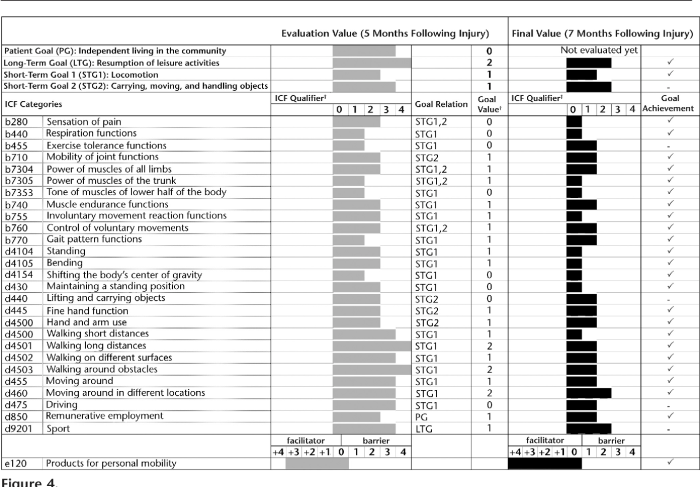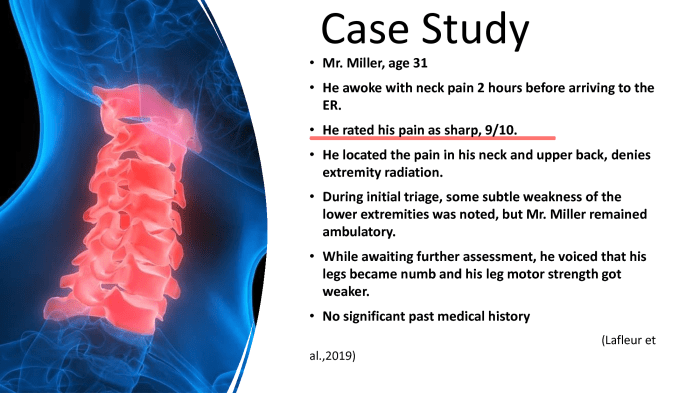The spinal cord injury case study HESI delves into the intricacies of spinal cord injuries, providing a thorough examination of their pathophysiology, management, rehabilitation, and nursing implications. This captivating narrative unfolds with a detailed analysis of a specific case, shedding light on the challenges and complexities of caring for individuals with spinal cord injuries.
The study explores the mechanisms of primary and secondary spinal cord injury, classifying injuries based on completeness and anatomical location. It elucidates the neurological deficits associated with these injuries and discusses the principles of acute management, including immobilization, surgery, and medical interventions.
Case Study Overview

This case study analyzes a 25-year-old male patient with a traumatic spinal cord injury at the T12 level.
The patient was involved in a motor vehicle accident and sustained a complete spinal cord injury. He presents with paraplegia, loss of sensation below the level of the injury, and neurogenic bowel and bladder dysfunction.
Pathophysiology of Spinal Cord Injury: Spinal Cord Injury Case Study Hesi

Mechanisms of Injury
Spinal cord injury occurs when there is damage to the spinal cord, which is a bundle of nerves that runs from the brain down the back.
The most common cause of spinal cord injury is trauma, such as from a car accident, fall, or sports injury.
Trauma can cause the spinal cord to be compressed, stretched, or torn.
There are two types of spinal cord injuries: primary and secondary.
Primary spinal cord injuryis the immediate damage to the spinal cord that occurs at the time of injury.
Secondary spinal cord injuryis the damage that occurs in the hours and days following the initial injury.
Secondary spinal cord injury is caused by a number of factors, including inflammation, swelling, and ischemia (lack of blood flow).
Types of Spinal Cord Injuries
Spinal cord injuries are classified according to the severity of the injury.
Complete spinal cord injuriesare injuries in which there is no motor or sensory function below the level of the injury.
Incomplete spinal cord injuriesare injuries in which there is some motor or sensory function below the level of the injury.
Spinal cord injuries are also classified according to the level of the injury.
Cervical spinal cord injuriesare injuries that occur in the neck.
Thoracic spinal cord injuriesare injuries that occur in the chest.
Lumbar spinal cord injuriesare injuries that occur in the lower back.
Sacral spinal cord injuriesare injuries that occur in the pelvis.
Neurological Deficits, Spinal cord injury case study hesi
Spinal cord injuries can cause a variety of neurological deficits, depending on the severity and level of the injury.
These deficits can include:
- Paralysis
- Loss of sensation
- Neurogenic bowel and bladder dysfunction
- Sexual dysfunction
- Spasticity
- Pain
FAQ Guide
What is the significance of the spinal cord injury case study HESI?
The spinal cord injury case study HESI provides a comprehensive examination of spinal cord injuries, offering healthcare professionals a valuable resource for understanding their pathophysiology, management, rehabilitation, and nursing implications.
What are the key elements of the spinal cord injury case study HESI?
The spinal cord injury case study HESI includes an in-depth analysis of a specific case, exploring the patient’s presentation, diagnosis, treatment plan, and rehabilitation journey. It also examines the challenges and complexities involved in managing and rehabilitating individuals with spinal cord injuries.
How does the spinal cord injury case study HESI contribute to the field of spinal cord injury care?
The spinal cord injury case study HESI contributes to the field of spinal cord injury care by providing a detailed examination of the multifaceted aspects of these injuries. It highlights the importance of interdisciplinary collaboration and patient-centered care, offering valuable insights for healthcare professionals involved in the management and rehabilitation of individuals with spinal cord injuries.